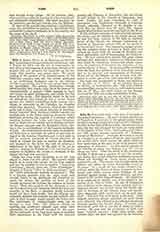

John II, POPE (533-535).—The date of the birth of this pope is not known. He was a Roman and the son of Projectus; if not born in the second region (Coelimontium) he had at least been a priest of St. Clement’s Basilica on the slope of Mons Coelius. He seems to have been the first who changed his name on being raised to the papacy (January 2, 533). The basilica of St. Clement still retains several memorials of “Johannes surnamed Mercurius”. Presbyter Mercurius is found on a fragment of an ancient ciborium, and several of the marble slabs which enclose the schola cantorum bear upon them, in the style of the sixth century, the monogram of Johannes. At this period simony in the election of popes and bishops was rife among clergy and laity. After the death of the predecessor of John II there was a vacancy of over two months, and during that period shameless trafficking in sacred things was indulged in. Even sacred vessels were exposed for sale. The matter was brought before the Senate, and before the Arian Ostrogothic Court at Ravenna. As a result the last decree (Senatus Consultum) which the Senate of Rome is known to have issued, and which, passed under Boniface II, was directed against simony in papal elections, was confirmed by the Gothic King Athalaric. He ordered it to be engraved on marble, and to be placed in the atrium of St. Peter’s (533). By one of Athalaric’s own additions to the decree, it was decided, that if a disputed election was carried before the Gothic officials of Ravenna by the Roman clergy and people, three thousand solidi would have to be paid into court. This sum was to be given to the poor. John himself, however, always remained on good terms with Athalaric, who referred to his tribunal all action. brought against the Roman clergy. Justinian also showed his good will to the See of Rome in John’s person. He sent him his profession of faith and many valuable presents. Some time before John became pope, the East was agitated by the formula, “One of the Trinity has been crucified”, which had been put forward as a means of reconciling various heretical sects. Condemned by Pope Hormisdas, the formula fell out of use. Afterwards revived, it was in a modified form defended by Justinian, and opposed by the Acoemetae, or sleepless monks. But they were condemned by the pope who informed the emperor of his action (March 24, 534). The crimes of Contuineliosus, Bishop of Riez, in Provence, caused John to order the bishops of Gaul to confine him in a monastery. Till a new bishop should be appointed he bade the clergy of Riez obey the Bishop of Arles. Two hundred and seventeen bishops assembled in council at Carthage (535) submitted to John II the question as to whether bishops who had lapsed into Arianism should, on repentance keep their rank or be admitted to lay communion. The answer to their question was given by Agapetus, as John II died May 8, 535. He was buried in St. Peter’s.
HORACE K. MANN

